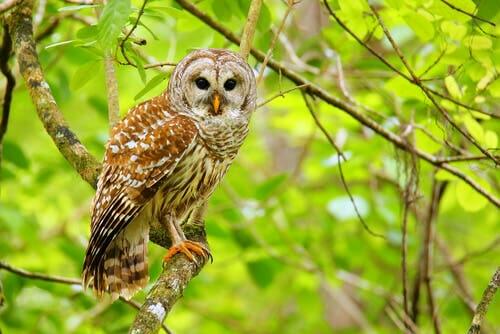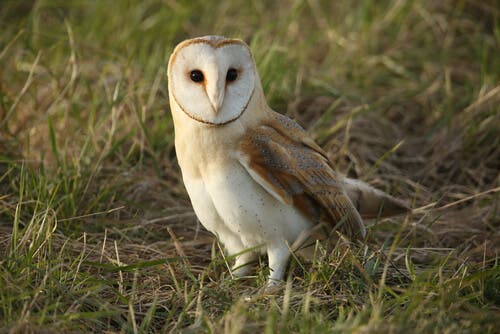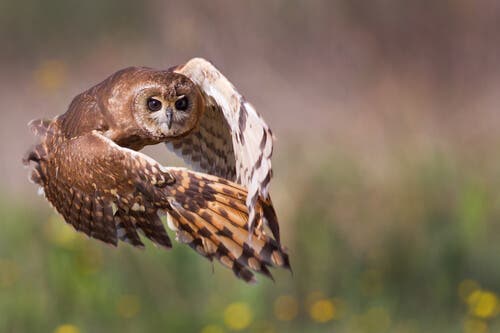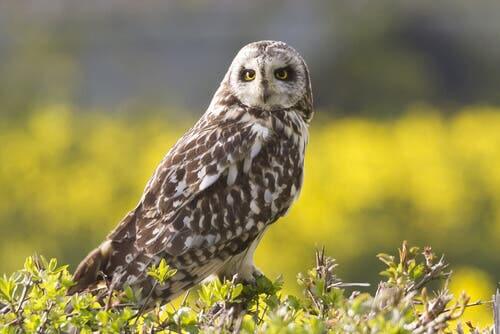Meet 4 Interesting and Beautiful Species of Owl

Within the owl family, there are different species with different sizes, yet similar in appearance and with similar habits. In this article, we’ll talk about some of these beautiful birds that live in mountainous environments.
Species of owl: How many are there?
Owls are birds we can find living in forests and mountains, and in order to communicate with each other, they perform a kind of a squeaking sound. They are solitary almost all year round (except when looking for a mate) and males are usually quite territorial.
Something that we find interesting about these animals is that they take advantage of the rain and use it to bathe and stay clean. In addition, they also love to dive into natural pools and fountains!
Some of the species of owl that we can find in the wild are:
1. Barred owl
Its scientific name is “Strix varies” (this article’s featured photo). The adults can be anywhere around 16 to 25 inches in length while its wingspan may range from 38 to 49 inches long and can weigh around 2 lbs. In addition, females are considerably larger than males.
As for its physical characteristics, the North American Barred owl has a pale face with dark circles around its eyes. Moreover, this is the only owl with this color and tone, and also has a yellow-colored beak. Its feathers are grey and brown with some light markings and dark horizontal ‘bars’ on the chest. In addition, both the legs and the claws are covered in feathers.
The Barred owl lives in the United States, Canada, and Mexico, particularly in dense forests. It’s an opportunistic predator that feeds on rats, rabbits, bats, moles, weasels, or mink.
2. Barn Owl
Also known as the common barn owl, it’s one of the most widely distributed birds in the world. Most of them are between 13 and 15 inches in length, with wingspans ranging from 31 to 37 inches. The known weight of barn owls ranges from 8 to 25 oz approximately.

One of its main features is the white ‘heart’ shape of his face. Its belly is white-colored, while its wings are short and light brown and its claws are covered with grayish feathers.
This bird prefers to place its nest in urban areas developed by humans such as bell towers, barns, or abandoned houses. However, the common barn owl doesn’t actually build its nests but rather takes advantage of the shelter it finds in its environment.
The females lay between four and seven eggs and incubate them for around 30 days, while the male forages for food. Their diet mainly consists of rodents, small birds, and insects.
3. Marsh owl
This bird lives mostly in sub-Saharan Africa, especially in northern Morocco, and is also found in the mountains of Madagascar. It prefers to hunt in open fields during the day, and it feeds on insects and rodents. It’s common to see them perched on low poles or even on the ground.

When nesting, it also does so at ground-level. It chooses clear wetlands to lay its four eggs well hidden among the vegetation.
In relation to its physical characteristics, this blackish owl measures about 15 inches long and has a wingspan of around 39 inches. Its plumage is brown at the top and white at the bottom. Its eyes are yellow with black irises, and its long wings allow it to glide stealthily when it’s hunting.
4. Short-eared owl
The short-eared owl is one of the nocturnal birds of prey that also performs activities during the daytime. It prefers open areas to live, crops, heath lands, and coastal marshes. Moreover, as long as prey is available, this owl will certainly have its home there.

Its eyes are yellow with black edges, a white belly with a few dark stripes and wings that have a light stripe that ends in a black tip. It will migrate during the winter towards warmer areas and hunt slowly over the ground. Its diet is based on rodents and small birds.
When building its nests, the female will choose grasslands or marshes. It will lay between four and eight eggs a year and will incubate them for just over a month. In addition, the chicks will get out of the nest after being around 4 weeks old. Seven days later after this, they’ll learn how to fly.
These are some of the most beautiful species of owl that live in our world. What do you think? Until next time!